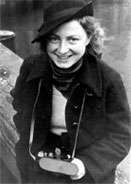Hansel Mieth
Hansel Mieth (1909–1998) was a German-born photojournalist who worked on the staff of LIFE Magazine. She was best known for her social commentary photography which recorded the lives of working class Americans in the 1930s and 1940s.[1]
Hansel Mieth | |
|---|---|
 Hansel Mieth, 1936, by Peter Stackpole | |
| Born | Johanna Mieth April 9, 1909 Berglen, Germany |
| Died | February 14, 1998 (aged 88) Santa Rosa, California, United States |
| Nationality | German-American |
| Known for | Photography |
| Spouse(s) | Otto Hagel ( m. after 1940) |
Biography
She was born Johanna Mieth in Oppelsbohm, Germany, one of three daughters of a strict, religious family. She ran away from home at the age of 15 and did factory work before emigrating to the United States in 1930 to join her lover and fellow photographer Otto Hagel (1909–1973). The couple found themselves in the midst of the Great Depression and worked as migrant farm labourers for several years.[2] During that time they began to photograph the brutal working conditions and suffering they saw around them, after acquiring a second-hand Leica camera. In San Francisco, Sacramento, and in the rural towns they worked in, they photographed the bitter labour strikes and the working homeless. They were involved with the San Francisco Film and Photo League during the early 1930s. They also became acquainted with working photographers and began to sell their own photographs to magazines.
In 1937 Mieth joined the staff of LIFE Magazine (only the second woman photographer to do so), and she and Otto (whom she married in 1940[2]), moved to New York. He was then still a German citizen, so in order to escape internment during the Second World War the couple fled to a remote ranch near Santa Rosa in northern California. Mieth continued to accept photography assignments for LIFE, while Hagel never left the Singing Hills Ranch.
During World War II Mieth photographed Japanese Americans who had been taken from their homes and interned by the Roosevelt government. In the early 1950s, the couple's refusal to appear before the House Un-American Activities Committee (where they would have been required to name names of their friends in the labour movement) led to Mieth's losing her job at LIFE, and to their being unofficially blacklisted. Shunned by their former friends, the couple retired to their ranch in California where they raised livestock and where Mieth took up painting. She died in Santa Rosa California in 1998.
Mieth's life story was told in a one-hour documentary titled Hansel Mieth: Vagabond Photographer, directed by Nancy Schiesari, which aired on PBS' Independent Lens series in 2003.
The full archive of Hansel Mieth's work is located at the Center for Creative Photography (CCP) at the University of Arizona in Tucson, which also manages the copyright of her work.[1]
References
- "Hansel Mieth". Center for Creative Photography. University of Arizona. Retrieved 4 December 2017.
- Hostetler, Lisa. "Hansel Mieth (1909 - 1998) German". International Center of Photography. Retrieved 4 December 2017.
Further reading
- Mieth, Hansel "On the Life and Work of Otto Hagel and Hansel Mieth as Narrated by Hansel Mieth". Left Curve no. 13 . 1988
- Flamiano, Dolores. "Meaning Memory and Misogyny: Life Photographer's Hansel Mieth's Monkey Portrait" Afterimage, Sept/Oct. 2005 p22
- Light, Ken (2010). Witness in Our Time Working Lives of Documentary Photographers. Smithsonian Books. ISBN 1299577741.
- Leshne, Carla. "The Film & Photo League of San Francisco", Film History: An International Journal - Volume 18, Number 4, 2006, pp. 361–373
- McCusker, Carol; Goldberg, Vicki (2006). Breaking the frame. San Diego, CA: Museum of Photographic Arts.
- Street, Richard Steven.Photographing Farmworkers in California Stanford University Press, 2004
- Rosenblum, Naomi (2014). A history of women photographers (3rd ed.). New York, NY: Abbeville. p. 232.
- Zandy, Janet. Unfinished Stories: The Narrative Photography of Hansel Mieth and Marion Palfi 2013. ISBN 978-1-933360-76-8
External links
Further reading
- Mieth, Hansel; Hagel, Otto; Knubben, Thomas. Simple life : Hansel Mieth, Otto Hagel : Fotografien aus Amerika 1929-1971. : Schmetterling Verl., 1991.
- Inouye, Mamoru; Mieth, Hansel; Hagel, Otto; Schaub, Grace. The Heart Mountain story : photographs by Hansel Mieth and Otto Hagel of the World War II internment of Japanese Americans. [Los Gatos, Calif.] : M. Inouye, ©1997.
- McCusker, Carol (2006). Breaking the frame : pioneering women in photojournalism, Thérèse Bonney, Olga Lander, Hansel Mieth, Grace Robertson, Esther Bubley, Margaret Bourke-White. Museum of Photographic Arts.